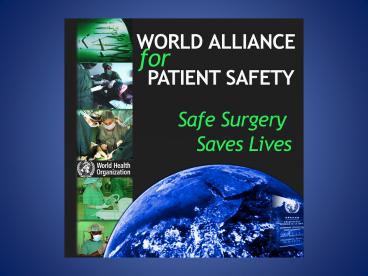Surgical safety is a serious public health issue - PowerPoint PPT Presentation
1 / 21
Title:
Surgical safety is a serious public health issue
Description:
... administration of anaesthetics, while protecting the patient from ... Participate in a program that identifies your hospital as a leader in patient safety ... – PowerPoint PPT presentation
Number of Views:78
Avg rating:3.0/5.0
Title: Surgical safety is a serious public health issue
1
2
Surgical safety is a serious public health issue
- About 234 million operations are done globally
each year - A rate of 0.4-0.8 deaths and 3-16 complications
means that at least 1 million deaths and 7
million disabling complications occur each year
worldwide
3
WHOs 10 Objectives for Safe Surgery
- The team will operate on the correct patient at
the correct site. - The team will use methods known to prevent harm
from administration of anaesthetics, while
protecting the patient from pain. - The team will recognize and effectively prepare
for life-threatening loss of airway or
respiratory function. - The team will recognize and effectively prepare
for risk of high blood loss. - The team will avoid inducing an allergic or
adverse drug reaction for which the patient is
known to be at significant risk.
4
WHOs 10 Objectives for Safe Surgery (cont)
- The team will consistently use methods known to
minimize the risk for surgical site infection. - The team will prevent inadvertent retention of
instruments or sponges in surgical wounds. - The team will secure and accurately identify all
surgical specimens. - The team will effectively communicate and
exchange critical information for the safe
conduct of the operation. - Hospitals and public health systems will
establish routine surveillance of surgical
capacity, volume and results.
5
What is this tool that addresses the 10
objectives?
6
(No Transcript)
7
(No Transcript)
8
(No Transcript)
9
The Checklist was piloted in 8 cities
EURO
EMRO
PAHO I
London, UK
Amman, Jordan
Toronto, Canada
WPRO I
Manila, Philippines
PAHO II
Seattle, USA
WPRO II
Auckland, NZ
AFRO
Ifakara, Tanzania
SEARO
New Delhi, India
10
- ...and was found to reduce the rate of
postoperative complications and death by more
than one-third!
Haynes et al. A Surgical Safety Checklist to
Reduce Morbidity and Mortality in a Global
Population. New England Journal of Medicine
360491-9. (2009)
11
Results All Sites
Haynes et al. A Surgical Safety Checklist to
Reduce Morbidity and Mortality in a Global
Population. New England Journal of Medicine
360491-9. (2009)
12
Change in Death and Complications by Income
Classification
plt0.05
Haynes et al. A Surgical Safety Checklist to
Reduce Morbidity and Mortality in a Global
Population. New England Journal of Medicine
360491-9. (2009)
13
What problems does this checklist address?
- Correct patient, operation and operative site
- There are between 1500 and 2500 wrong site
surgery incidents every year in the United
States.¹ - In a survey of 1050 hand surgeons, 21 reported
having performed wrong-site surgery at least once
during their careers.²
¹ Seiden, Archives of Surgery, 2006. ²
Joint Commission, Sentinel Event Statistics, 2006.
14
What problems does this checklist address? (cont.)
- Safe Anaesthesia and Resuscitation
- An analysis of 1256 incidents involving general
anaesthesia in Australia showed that pulse
oximetry on its own would have detected 82 of
them.¹
¹ Webb, Anaesthesia and Intensive Care, 1993.
15
What problems does this checklist address? (cont.)
- Minimizing risk of infection
- Giving antibiotics within one hour before
incision can cut the risk of surgical site
infection by 50¹, ² - In the eight evaluation sites, failure to give
antibiotics on time occurred in almost one half
of surgical patients who would otherwise benefit
from timely administration
¹ Bratzler, The American Journal of Surgery,
2005. ² Classen, New England Journal of Medicine,
1992.
16
What problems does this checklist address? (cont.)
- Effective Teamwork
- Communication is a root cause of nearly 70 of
the events reported to the Joint Commission from
1995-2005.¹ - A preoperative team briefing was associated with
enhanced prophylactic antibiotic choice and
timing, and appropriate maintenance of
intraoperative temperature and glycemia.², ³
¹ Joint Commission, Sentinel Event Statistics,
2006. ² Makary, Joint Commission Journal on
Quality and Patient Safety, 2006. ³ Altpeter,
Journal of the American College of Surgeons, 2007.
17
Why should your hospital adopt the Checklist?
- It is a primary recommendation in the new WHO
Guidelines for Safe Surgery - The Checklist has been endorsed by over 200
surgical, anaesthesia, and nursing organizations
across the world - At least 3 nations have committed to instituting
the Checklist in all operating rooms
18
Advantages of Using a Checklist
- Customizable to local setting and needs
- Deployable in an incremental fashion
- Supported by scientific evidence and expert
consensus - Evaluated in diverse settings around the world
- Ensures adherence to established safety practices
- Minimal resources required to implement a
far-reaching safety intervention
19
What can you do?
- Register on the WHO website as a participating
hospital - Implement the Surgical Safety Checklist in your
hospital - Measure results such as deaths and complications
and give feedback on checklist implementation
based on your personal experience
20
Support for implementation
- WHO Guidelines for Safe Surgery
- Additional resources available online at
- www.who.int/safesurgery
- www.safesurg.org
- Web-based community of hospitals, organizations,
and clinicians participating in this program - Safe Surgery Saves Lives Program Team based in
Geneva and Boston
21
Why should you get involved?
- Save lives and prevent complications
- Reduce medical costs related to errors
- Become a part of a supportive international
online network of providers and hospitals using
the checklist - Participate in a program that identifies your
hospital as a leader in patient safety































